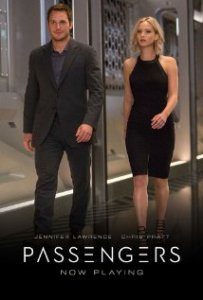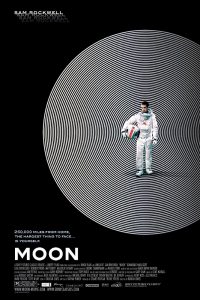Starshipboard Romance: A Review of Passengers
 by Gary Westfahl
by Gary Westfahl
There are several reasons to admire Passengers: it addresses a topic that is usually avoided in science fiction films – how humanity might colonize the galaxy without the magic of faster-than-light travel; its starship is filled with imaginative visual touches; and its story is genuinely unpredictable, consistently holding one’s interest despite a small cast and limited sets. And yet, there is also something strangely incongruous about the film, as its uneasy blend of disparate elements sometimes makes it seem like a film at war with itself.
As one issue to discuss, consider the two types of space films that I identified in my book The Spacesuit Film: A History, 1918-1969 (2012). First, there are relatively small numbers of spacesuit films, which acknowledge and depict the harsh, potentially lethal environments of outer space and typical planets and therefore have their protagonists regularly don spacesuits. Second is the broader category of space films, which usually posit, implausibly, that space travel will solely be a matter of voyaging within safe, comfortable vehicles to hospitable Earth-like worlds, never requiring spacesuits, as in the Star Trek and Star Wars universes. Quite unusually, Passengers solidly fits into both categories.
On one hand, the two starship passengers prematurely awakened from hibernation – Jim Preston (Chris Pratt) and Aurora Lane (Jennifer Lawrence) – do sometimes put on spacesuits and venture into space; the film addresses one genuine danger of space travel, a breach in the hull that would precipitously suck all the air out of a chamber; much of the starship Avalon resembles a standard spaceship, with grey metallic walls and rooms filled with machinery; and two of the film’s incidents are traditional in spacesuit films, a crewman going outside of one’s spacecraft to effect repairs, and an astronaut perilously drifting farther and farther into the depths of space, demanding a valiant rescue attempt. Strikingly, the first two women to take space walks in films – Ana Luisa Peluffo in the Mexican film Conquistador de la Luna (1960) and June Lockhart in the first episode of Lost in Space, “The Reluctant Stowaway” (1965) – both put on their spacesuits to rescue male companions stranded in space; Lawrence at one point does the same. Certain stereotypes – men enter space seeking adventure, women enter space seeking true love – may never die; and though Lawrence announces other reasons for her space voyage, the parting words of a friend on Earth are, “I hope you find someone to fill your heart, and I hope you let him in.”
Two interestingly contrasting scenes explore the emotional impact of space: while he is still the only passenger awake, Preston goes drifting through space by himself, leading him to shed a tear and contemplate suicide; space can be dauntingly cold and forbidden. But later, when he takes Lane with him, they seem to celebrate the wonders and freedom of space as they float together, recalling the way that the robots Wall-E and Eve soar through space in Wall-E (2008 – review here). Clearly thrilled, Lane says “Thank you” to Preston for providing her with that experience, and she immediately falls in love with him, prompting a comic scene wherein their bulky spacesuits hinder their efforts to enjoy a first kiss.
On the other hand, when they aren’t taking walks in space, Preston and Lane are living within a fantastically, and unnecessarily, spacious vehicle, made comfortable by some unexplained form of artificial gravity; and amidst the generally spartan quarters there are islands of luxury, like the old-fashioned bar staffed by the humanoid robot Arthur (Michael Sheen), a swimming pool, and fancy French, Mexican, and Chinese restaurants – oddly staffed by non-humanoid robots. The overall look of the Avalon may have been influenced by the similarly huge starship of Czech film Ikarie XB-1 (1963), though it had no passengers in hibernation. The ship also contains versions of Star Trek’s Holodeck, as Preston plays games involving full-sized holograms of dancers and basketball hoops, and the constantly attentive robots, and robotic voices, recall another aspect of Wall-E – the gigantic spaceship that pampered and overprotected Earth’s displaced citizens. All of this suggests that traveling through space will be like going on a pleasant cruise, as in typical space films, although the protagonists here occasionally take a bracing plunge into the more austere world of the spacesuit film.
The science behind the story is also an odd mixture of logic and illogic. The Avalon is propelled by a “fusion drive” – a technology for interstellar flight that has been seriously proposed – and over time, such an engine might actually get a starship to move at half the speed of light, as crew member Gus Mancuso (Laurence Fishburne) reports. And placing passengers in hibernation for journeys to other stars that take decades, if not centuries, also seems a reasonable and eventually realizable system. However, unlike other recent spacesuit films like Gravity (2013 – review here) and The Martian (2015 – review here) , Passengers fails to credit anyone as a “science advisor,” and sometimes it shows. For one thing, I don’t think someone could survive for a second, let alone several minutes, in close proximity to a malfunctioning fusion reactor. Also, in other science fiction portrayals of interstellar travel at sublight speeds, as in Arthur C. Clarke’s The Songs of Distant Earth (1986), the starship has the capacity to both remove people from hibernation and place them back in hibernation, and some members of a rotating crew are always awake, seemingly essential measures to deal with unexpected problems. On the Avalon, everybody is in hibernation, and if someone awakens accidentally, there is no way to return them to hibernation. And if a starship like this one was indeed placed entirely on “autopilot,” there would surely be an overarching intelligence in charge, like HAL 9000 in 2001: A Space Odyssey (1968), again as an obvious safety measure; here, all of the starship’s robotic intelligences appear to operate independently, so that one of them tells Preston that the ship is about to reach the planet Homestead II while another reports, more accurately, that it will not do so for another ninety years.
One minor problem probably bothered me more than it should have. We told that the ship is on a 120-year journey, traveling at about half the speed of light. While it would require some time to accelerate to that speed, and to decelerate as it approaches its destination, one could roughly guess that it is traveling about sixty light years – and, as it happens, there are several stars with known planets at about that distance. Preston and Lane have awakened after 30 years, so they must be about fifteen light years away from Earth. Yet in one of the film’s most spectacular scenes, they get a close-up view of the red giant star Arcturus as the Avalon swings around it, presumably to get a boost from its gravity. But Arcturus is 36.7 light years from Earth, so the starship could never reach it in 30 years, even traveling at the speed of light. It would have required about five minutes of online research to find the name of a star that Preston and Lane might have actually observed, but clearly, no one thought that this was important. (True, one might endeavor to explain this away by arguing that, on a ship traveling at great speed, time would slow down, so that a journey that would seem to last thirty years to observers on Earth might feel like only fifteen years to passengers on the ship; but there is no indication that anyone involved with this film was even aware of this issue.)
Beyond its occasional indifference to science, Passengers also seems curiously unmoved by the motive behind its science – the goal of colonizing new planets throughout the galaxy. Journalist Lane properly calls this “the biggest story there is,” explaining her desire to report it, and one might imagine that it would lead to a truly epic film, depicting thousands of people banding together to forever leave their homes in order to conquer a virgin planet, and inspiring audiences to support space travel as a way to someday provide humanity with wondrous new homes. Yet this film instead focuses on two individuals who are forced to abandon their aspirations, destined to become forgotten footnotes to a grand historical saga. Lane even suggests that people are fundamentally incapable of achieving great things: “we are not captains of our fate …. we’re passengers – we go where fate takes us.” Presumably, space travel only occurs because fate sometimes pushes people into space and sometimes doesn’t.
The film further belittles space travel by indicating, reflecting recent trends, that interstellar colonization will be undertaken not by governments but by private corporations, solely focused on making profits. From Lane’s perspective, as Preston puts it, the Avalon is transporting “5000 suckers” foolishly lured to another planet merely to make other people rich. The evils of corporate greed are underlined by the exorbitant price of Preston’s distress message to Earth, and by the fact that Lane cannot research how to place herself in hibernation because “Hibernation technology is proprietary.” Of course, attacking avaricious companies as baleful engines of space exploration is nothing new in science fiction films, having been a recurring theme of Alien (1979) and its sequels.
To summarize the argument so far, one could say that Passengers, despite some good features, lacks both the scientific rigor, and forward-looking vision, that is usually associated with superior science fiction. But director Morten Tyldum and screenwriter Jons Spaihts might respond that this is all beside the point; their film is primarily a character study, focused on how a relationship might develop between unlikely individuals in uniquely stressful circumstances. Yet the film is also problematic if examined within that context.
In some respects, this film’s story recalls James Cameron’s Titanic (1997) – as suggested when Lane announces that “we’re stranded on a sinking ship.” In both films, a lower-class man and an upper-class woman, on an apparently doomed voyage, improbably meet and fall in love, and the man is later prepared to sacrifice his own life to save his beloved. To achieve this dynamic, the film must adjust its terminology: Preston is initially identified as a “mechanical engineer” – you know, someone who can design and build factories – but he is later described as a “mechanic” – you know, someone who can fix broken radios and toasters. In fact, we are told he wants to immigrate to another world because he feels useless on Earth, where broken items are replaced; on a colony planet, a person who can repair items will be appreciated. Preston also comes from Denver, Colorado, close to the wilderness, while Lane lives in sophisticated New York City, writing as she gazes at the Chrysler Building. As another sign that he is déclassé, Preston is also a jerk, as he wakes Lane from hibernation – dooming her to die on the ship before reaching her destination – solely to relieve his own loneliness.
In contrast, Lane is a wealthy “Gold Star” passenger, eligible to get much better breakfasts than Preston’s humble fare, and while her famous father may have provided a substantial inheritance, she makes her living with her intellect, not her hands, as either a “writer” or a “journalist” (also somewhat different professions). However, although there have been many memorable journalists in films, the screen generally does a poor job of depicting writers, and Lane exhibits most of the typical flaws. For the record, actual writers talk like everybody else, spend most of their time alone, writing, expect and receive little praise, and feel constantly insecure about the quality of their writing. Lane periodically responds to situations by dispensing lame platitudes; though we are once told she has done some writing, she usually seems to be doing something else; her writing is said to be so wonderful as to make Preston fall in love with her, though I was not particularly impressed by the visible samples; and Lane seems entirely too pleased by her own talents, once announcing that she has just done “her best writing” to date. In sum, if Lane actually epitomized everything it means to be a writer, I’d rather be a mechanic.
When two key characters seem fundamentally unlikable, the problem can sometimes be overcome by effective acting, and I would say that Pratt and Lawrence almost succeed in doing so. But Pratt ultimately overuses his characteristic, “I’m really a sensitive guy” expression, making one long for additional scenes of Lawrence smacking him in the face. And while Lawrence excels at being sad, angry, and irritable, she is rarely persuasive when asked to be happy; she connects with audiences, I think, because they feel sorry for her, not because they like her.
Another problem with these characters involves their actions in the film’s final scenes, which I will discuss as vaguely as possible. When protagonists do unforgiveable things, they should not be forgiven, and they should not be rewarded with happy endings; Macbeth cannot end with King Macbeth apologizing for killing all those people and resolving to henceforth be a morally scrupulous ruler, while Macduff graciously accepts his apology and promises to become his loyal subject. But in contemporary Hollywood, it requires a considerable amount of courage to provide an appropriate ending if it is not an entirely happy ending; and I will simply note that, in this respect, Tyldum and Spaihts do not prove to be particularly courageous.
As a welcome respite from Preston and Lane, the film might have devoted more screen time to Mancuso, arguably its most sympathetic character; but Fishburne is woefully underutilized, as his character functions solely as a device to jump-start the plot before he vanishes from the scene. Another veteran actor, Andy Garcia, has so little to do, despite his fifth billing, that I could not honestly list him in the accompanying credits. And Sheen’s Arthur is pleasant enough, but clearly not very smart and relentlessly superficial; perhaps Preston could excuse his behavior by stating that a year of Arthur’s company had driven him insane. The other robotic voices and holograms throughout the ship have even less intelligence, and merely reinforce the film’s obvious message about the dangers of overly relying on technology.
Like its characters, Passengers experienced a long journey to theatres, with several different directors and stars involved along the way, and there are reports that its story was still being tinkered with as late as last October; perhaps its release should have been postponed, to provide even more time for additional improvements. For it is a good film that could have been a better film with a little more attention to its science, story, and characters. But like Aurora Lane, I suppose, filmgoers sometimes must settle for what fate provides us.







